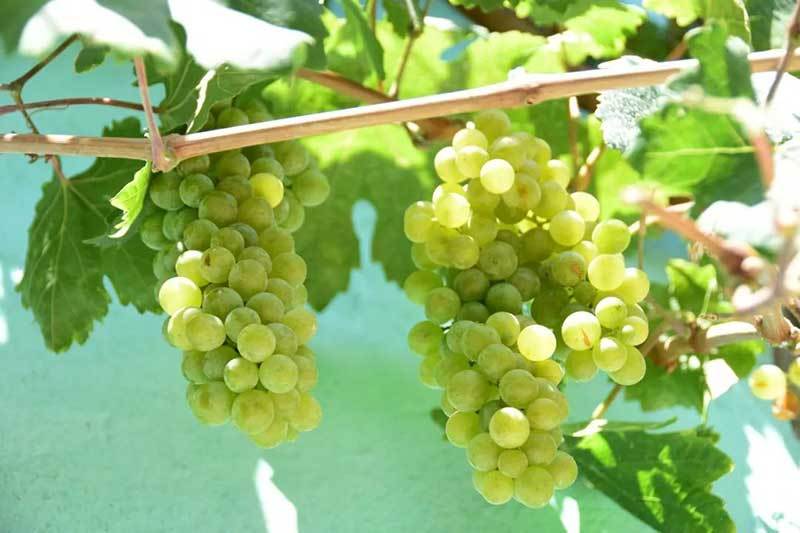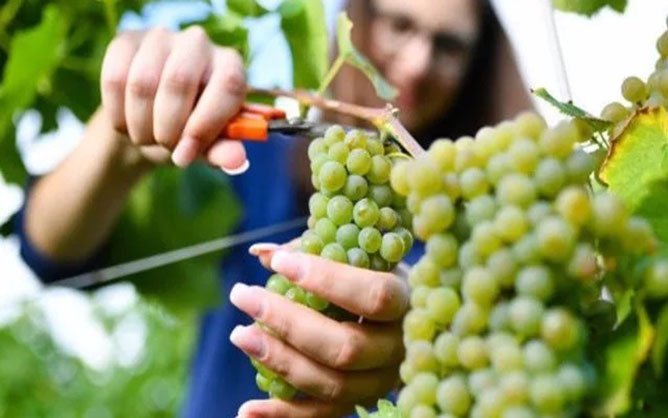How to Grow Cotton Candy Grapes: The Ultimate Guide
Introduction
Cotton candy grapes have become an increasingly popular snack in recent years. They are sweet and juicy, which makes them stand out from ordinary grapes. You can enjoy this unique fruit whenever you’d like by growing your own, without having to rely on store-bought varieties. Plus, there’s something immensely satisfying about harvesting the fruits of your labor right from your very own backyard.
Can you grow cotton candy grapes? This guide will provide all the information to successfully grow your own Cotton Candy Grapes. We’ll cover everything from selecting an appropriate variety of grapevine to planting and caring for it. As well as how to harvest the sweet fruits when they’re ready.
You can grow cotton candy grapes in no time by following these simple steps. This not only provides you with a delicious snack year round, but also improves your skills: from pruning and training vines to harvesting the grapes at just the right time. Let’s get started!
Understanding Cotton Candy Grapes
The origin and history of cotton candy grapes: They were first developed in the late 1990s by horticulturalist David Cain and his team. They at the International Fruit Genetics research facility in California. The grapes are created through a cross between two vines, a Thompson Seedless and a Flame Seedless variety. This hybridization gives them their unique, sweet flavor profile reminiscent of cotton candy.
The unique flavor of cotton candy grapes: They have become increasingly popular due to their distinct flavor. They are more pleasant than other types of grapes. These grapes are ultra-sweet. They almost have no hint of tartness or tannins like other grape varieties might have. Cotton candy grapes are also larger than most other types. This makes them a great snack.
The nutritional value of cotton candy grapes: Cotton candy grapes also have many health benefits. They are rich in antioxidants, vitamin C, potassium etc. These can improve heart health, reduce inflammation and increase energy levels.

Choosing the Right Variety
Popular cotton candy grape varieties: There are a few different varieties to choose from, each offering their own unique features. Some of the most popular options include Cotton Candy Delight, Early Sweet, and Sugar Crisp. Each variety has its own characteristics. They are desirable for different climates and soil conditions.
For example, Cotton Candy Delight is known for its excellent flavor and impressively large clusters of small-medium sized berries. Early Sweet have higher sugar content and can produce larger fruit. Sugar Crisp produces smaller fruits but is also amongst the sweetest varieties available.
Consider some important factors: Some varieties may not be suitable for extreme temperatures. So you should consider the climate in your area. They may struggle with a lack of sunshine or extended periods of rainfall.
You can grow different grapes at the same time. Do not choose varieties that will compete with each other. They will produce high-quality fruit when you plant them close together.
Soil conditions should also play a role in your decision-making process when selecting a variety. You can choose one that is compatible with the pH levels of your soil. It can tolerate potential nutrient deficiencies or waterlogging issues.
Tips on purchasing cotton candy grape vines: You can buy cotton candy grape plants from many nurseries and online retailers. They have different cotton candy grape plants for sale. You should do some research when choosing a supplier. You will get high-quality vines that are suitable for growing in your area.
You should take time to choose the right variety of cotton candy grapes. Then, you will be able to enjoy sweet, juicy fruit at harvest time. You should consider climate, soil conditions and availability. You will begin your journey into grape-growing with confidence and success!
Creating the Ideal Growing Environment
Growing cotton candy grapes is a fun way to add a unique treat to your garden. You should create the ideal environment to grow cotton candy grapes. This means paying attention to climate conditions, soil requirements and pH levels.
The climate conditions: Cotton candy grapes thrive in warmer weather but can withstand lower temperatures of up to 20 degrees Fahrenheit. The vines also need protection from high winds and extreme humidity or dryness.
Soil requirements and pH levels: Cotton candy grapes prefer a rich, loamy soil with a neutral pH level between 5.5 and 6.5. The soil should be well-draining, so it’s important to test drainage before planting the vines. If necessary, you can amend the soil with compost or other organic matter. This will improve its structure and increase water retention.
Prepare the soil for planting: You can use the soil which is aerate and loosened up to a depth of at least one foot. The roots will easily spread out and take in the necessary nutrients from the soil. After fertilizing, if needed, you can add mulch around the base of your cotton candy grape plants to help retain moisture during dry spells and protect against weeds.
Sunlight and proper drainage: Sunlight is an essential part of creating a healthy environment for your cotton candy grapes. They need at least six hours of direct sunlight each day to produce an abundant crop. Additionally, be aware of proper drainage. If your soil doesn’t drain well, it can lead to root rot and other issues that will damage the plants.
How to Grow Cotton Candy Grapes?
How do they grow cotton candy grapes? Planting Cotton Candy Grapes is an easy and rewarding endeavor. The sweet, juicy fruit they produce makes them a favorite of many home gardeners. It’s important to plant your cotton candy grapes at the right time of year for them to thrive.
The best time to plant cotton candy grape vines: Cotton candy grapes growing zone is USDA Growing Zones 5 - 8. You can start cotton candy grapes between December and February, depending on where you live. Before planting cotton candy grape vine plant, you should use well-draining soil rich in organic matter. You can also add some fertilizer at this time, as well as a layer of mulch around each vine for water retention.
How do you grow cotton candy grapes? When you’re ready to plant cotton candy grapes, dig a hole that is twice the size of the root ball. Gently place the vine in the hole and fill it back up with soil. Make sure that the graft union (the point where two different varieties are joined) is no more than one inch below the surface of your soil. Firmly press down the surrounding soil around each vine and water well.
The spacing requirements for optimum growth: You should give cotton candy grapes plenty of space in order for them to grow properly. The plant should have around six feet between each other. The vines will have enough room to spread out and the grapes will get plenty of sun exposure.
Trellising and vine support: Once your cotton candy grapes are planted, you should provide them with proper trellising and vine support. You can use a single wire that is supported by posts running along each row. Or use a two-wire system which has wires on both sides of the row.
These systems should be sturdy enough to hold up your grapevines when they grow and produce fruit. You should use heavy-duty anchors such as steel stakes or concrete blocks. Buried into the ground at least three feet deep.

Proper Care and Maintenance
Watering: Cotton candy grapes require consistent watering to support their growth from seedling to mature plants. During the early stages, they should be watered once per week with 1-2 inches of water. Avoid over-watering as this can cause root rot or other diseases.
When the plants become more established, watering can be reduced to every 5-7 days with 2-3 inches of water. In hot climates or during dry periods, you can provide extra water if needed.
Fertilization: Providing fertilizer will ensure that cotton candy grape vines receive essential nutrients such as nitrogen, potassium and phosphorus. This can help cotton candy grape plants healthy growth and maximum yields. A slow release organic fertilizer applied in the spring is recommended at a rate of 1 pound per 100 feet of row. You should apply every 3 months.
Pruning: Pruning cotton candy grape vines is important to encourage healthy growth and maximize yields. In the early stages of growth, remove any dead or damaged canes and thin out clusters of grapes to reduce competition for nutrients.
Once the vine begins producing fruit, prune off any leaves that are blocking sunlight from reaching the grapes or interfering with air circulation. Additionally, extra shoots should be removed as they appear to control the size and shape of the plant.
Pest and Disease Management: Cotton candy grapes can be susceptible to a variety of pests such as aphids, thrips, mites and whiteflies. In addition, powdery mildew is a common fungal disease. It can affect cotton candy grapes plants.
To control these pests and diseases, it is important to practice good garden hygiene. Remove any dead or damaged plants immediately. Additionally, organic methods such as insecticidal soaps, neem oil or beneficial insects can be used for pest management. Copper fungicides are an effective treatment for powdery mildew.
Harvesting Cotton Candy Grapes
The ideal time for harvesting: Cotton candy grapes are ready for harvesting when they have developed a creamy yellow color, slightly darker than the green hue of unripe fruit. The grapes should be firm yet slightly soft to the touch and have an intensely sweet aroma that signals ripeness.
It is important to pick the grapes at their peak. Because ripe grapes don’t store well and will quickly become overripe if left on the vine too long after they’ve reached maturity.
How to properly harvest the grapes without damaging the vines: Careful handling is key when harvesting cotton candy grapes. Because rough treatment can damage both the vines and the delicate fruits themselves.
Utilize gentle pressure with one hand while plucking off individual grape clusters with your other hand. Take care to avoid pulling the stems off with the fruit. Because this will encourage rot and make it impossible to store the grapes.
Storage tips: Post-harvest care is essential for preserving the shelf life of cotton candy grapes. Keep them refrigerated immediately after harvesting, ideally between 33°F and 40°F, until you’re ready to consume or use them in a recipe. Storing them at room temperature will cause them to overripen quickly. So keep that temperature low and check on your grape clusters regularly while in storage.
You can store them in an open container or loosely covered with plastic wrap. Just make sure there is plenty of air circulation around the grapes. You should separate the clusters into small containers if you are not planning to eat all of your grapes right away. Then, freeze them for up to three months.

Troubleshooting Common Issues
Common diseases and preventive measures: One of the most common issues gardeners may face when growing cotton candy grapes is disease. Incorrect soil pH, improper irrigation, or excessive nitrogen can all contribute to disease.
If you find discolored leaves or withered stems, it means your plant has been infected by fungi. You can treat the plant with an appropriate fungicide and reduce watering frequency until the symptoms subside. For bacterial diseases like crown gall or fire blight, prune away affected parts of the plant. Treat with copper-based bactericides if necessary.
Nutrient deficiencies and solutions: This can cause poor growth in cotton candy grapes. Iron deficiency is especially common in alkaline soil, producing yellowing of new leaves (interveinal chlorosis). To treat this issue, provide iron chelate fertilizer or spray with a liquid iron compound.
If magnesium levels are low and older leaves start yellowing around the edges (margin necrosis), supplement with Epsom salts or dolomitic lime. For nitrogen deficiencies causing stunted growth and pale foliage, regular applications of compost tea should be enough to restore the health of the plants.
FAQs about growing cotton candy grapes
How to grow cotton candy grapes from seeds?
Cotton candy grapes can be grown from seed, but it is important to use fresh seeds for the best chances of success. You should soak the seeds overnight in warm water before sowing them into a container filled with moist soil. Make sure the plastic pots have drainage holes and cover the seeds lightly with more soil.
Place the pot in an area that gets full sun and keep the soil consistently moist throughout the growing season. Once germination occurs, thin out any overcrowded plants to ensure each one has enough space to spread its roots. Erect stakes or trellises around your cotton candy grape plants to help guide their growth.
How long does it take for cotton candy grapes to mature?
Cotton candy grapes typically begin flowering and setting fruit after about two years of growth. During this time, they should be given adequate amounts of sunlight, water, and nutrients to pay attention to pests.
When do cotton candy grapes ripen?
Cotton candy grapes typically ripen in late summer or early autumn months. They are ready to harvest when their color turns from deep purple-blue to light greenish-yellow and their skins become thin and tender.
Can I eat cotton candy grapes right off?
Yes! Cotton candy grapes are perfectly safe to eat fresh off of the vine. But you may need to wait until they’re fully ripe before harvesting them. Just make sure not to over-harvest from any single plant in order to ensure continued production.
Conclusion
Cotton candy grapes are sweet and juicy. You can grow them in your own backyard. It is a rewarding and unique way to enjoy this delicious variety of grapes. If you’re looking for an easy way to add something special to your diet, then growing cotton candy grapes is definitely worth exploring. It also expands your gardening skills.
You can purchase cotton candy grape seedlings from a nursery or online. Then, grow cotton candy grapes directly on the ground. You can also propagate cotton candy grapes from cuttings if you want to save some money. With a little bit of patience and dedication, you’ll soon be enjoying the fruits of your labor.



